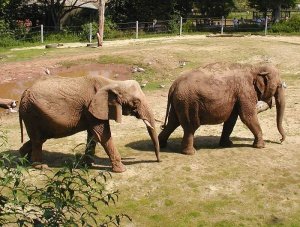Proboscidea is an order including only one extant family, Elephantidae or the elephants, with three species: the Savannah Elephant and Forest Elephant (which were collectively known as the African Elephant) and the Asian Elephant (formerly known as the Indian Elephant). During the period of the ice age there were more species, which are now extinct, including the elephant-like mammoth and mastodont and the "shovel tuskers": platybelodon and amebelodon. The earliest known proboscidean is Pilgrimella, and after that Moeritherium.
Elephants are the largest living land mammals. At birth it is common for an elephant calf to weigh 100 kg (225 pounds). It takes 20 to 22 months for a baby elephant to mature to birth, the longest gestation period of any land animal. An elephant may live as long as 60 to 70 years. The largest elephant ever recorded was a male shot in Angola in 1974, weighing 12 000 kilograms or 26 400 pounds.
Prehistoric man has been known to eat elephants, as recent findings of animal remains in central China show. The elephant is now a protected animal, and consumption is prohibited around the world.
Body characteristics
An elephant's most obvious characteristic is the trunk, a much elongated combination of nose and upper lip, which can be used to grab objects such as food. The tip of an elephant's trunk contains pacinian corpuscles. The trunk is a useful and muscular appendage that enables an elephant to reach food in high places and lift obstacle weight up to 1 ton. Elephants also have tusks, large teeth coming out of their upper jaws. Elephant tusks are the major source of ivory, but because of the increased rarity of elephants, hunting and ivory trade is now restricted and in some countries illegal.
Elephants have three premolars and three molars in each quadrant. They erupt in order from front to back, then wear down as the elephant chews its highly fibrous diet. When the last molar has worn out, the elephant typically dies of malnutrition; elephants in captivity can be kept alive longer than that by feeding them preground food. The molars of the African elephant are loxodont, hence the genus name.
Skin diseases often occur, from which they try to protect themselves by taking mud baths, shower one another with water from the trunk, and rolling in dust. The skin can therefore appear brown or reddish, but the natural color is light gray. Their coarse and wrinkled skin is sparsely bristled, and about 1 inch (25 mm) thick. There are also rare white elephants, who often have blue eyes. Otherwise elephants have brown eyes, surrounded by long lashes.
They have large ears that wave for cooling, and a relatively small tail with a brush at its tip.
Walking at a normal pace an elephant covers about 2 to 4 miles an hour (3 to 6 km/h) but they can reach 24 miles an hour (40 km/h) at full speed.
Diet
Elephants are vegetarians, spending 16 hours a day collecting plant food. Their diet is at least 50% grasses, supplemented with leaves, twigs, bark, roots, and small amounts of fruits, seeds and flowers. Because elephants only use 40% of what they eat they have to make up for their digestive system's lack of efficiency in volume. An adult elephant can consume 300 to 600 pounds (140 to 270 kg) of food a day. 60% of that food leaves the elephant's body undigested.
Varieties
It has long been known that the African and Asian elephants are separate species. African elephants tend to be larger than the Asian species (up to 4 m high and 7500 kg) and have bigger ears (which are rich in veins and thought to help in cooling off the blood in the hotter African climate). Female African elephants have tusks, while female Asian Elephants do not. African elephants have a dipped back, as compared with the Asian species, and have two "fingers" at the tip of their trunks, as opposed to only one.
There are two populations of African elephants, Savannah and Forest, and recent genetic studies have led to a reclassification of these as separate species, the forest population now being called Loxodonta cyclotis, and the Savannah (or Bush) population termed Loxodonta africanus. This reclassification has important implications for conservation, because it means where there were thought to be two small populations of a single endangered species, there may in fact be two separate species, each of which is even more severely endangered. There's also a potential danger in that if the forest elephant isn't explicitly listed as an endangered species, poachers and smugglers might thus be able to evade the law forbidding trade in endangered animals and their body parts.
Harvest
The harvest of elephants, both legal and illegal, has had some unexpected consequences on elephant anatomy as well. African ivory hunters, by killing only tusked elephants, have given a much larger chance of mating to elephants with small tusks or no tusks at all. The propagation of the absent-tusk gene has resulted in the birth of large numbers of tuskless elephants, now approaching 30% in some populations (compare with a rate of about 1% in 1930). Tusklessness, once a very rare genetic abnormality, has become a widespread hereditary trait. [1] It is possible, if unlikely, that continued selection pressure could bring about a complete absence of tusks in African elephants, a development normally requiring thousands of years of evolution. The effect of tuskless elephants on the environment, and on the elephants themselves, could be dramatic. Elephants use their tusks to root around in the ground for necessary minerals, tear apart vegetation, and spar with one another for mating rights. Without tusks, elephant behavior could change dramatically. [2]
Domestication
Elephants have been used in various capacities by humans. War elephants were used by armies in the Indian sub-continent, and by the Persian empire. This use was adopted by Hellenistic, Ptolemaic and Seleucid kingdoms. The Carthaginian general Hannibal took elephants across the Alps when he was fighting the Romans. Hannibal brought too few elephants to be of much military use, although his horse cavalry was quite successful. Hannibal probably used a now-extinct third African species, the North African elephant, smaller than its two southern cousins, and presumably easier to domesticate.

African Savannah Elephant (left) and Asian Elephant at an English zoo.

Elephant footprints (tyre tracks for scale)
Asian elephants have been used for transport and entertainment, and are common to circuses around the world. Throughout Siam, India, and most of South Asia they were used in the military, used for heavy labor, especially for uprooting trees and moving logs, and were also commonly used as executioners to crush the condemned underfoot.
However, elephants have never been truly domesticated: the male elephant in his periodic condition of musth is dangerous and difficult to control; elephants used by humans have typically been female. War elephants were an exception, however: as female elephants in battle will run from a male, only males could be used in war.
It is more economical to capture wild young elephants and tame them than breeding them in captivity.
African elephants are usually thought not able to be domesticated, but some entrepreneurs have succeeded by bringing Asian mahouts to Africa.
Social behavior
In the wild, elephants exhibit complex social behavior and strong family bonds. Most females will stay with their original natal group for a lifetime. Social hierarchy in calf-cow groups is based on size and age, with the largest and oldest females at the top and the smallest and youngest coming in last. Adolescent males determine their own ranking order through jousting contests using head and tusks, where strength and temperament are as important as size and age. They communicate with very low and long-ranging subsonic tones.
Evolution
Although the fossil evidence is uncertain, some scientists believe there is genetic evidence that the elephant family shares distant ancestry with the Sirenians (sea cows) and the hyraxes. In the distant past, members of the hyrax family grew to large sizes, and it seems likely that the common ancestor of all three modern families was some kind of amphibious hyracoid. One theory suggests that these animals spent most of their time under water, using their trunks like snorkels for breathing. It has recently been discovered that modern elephants can still swim using their trunks in that manner.
In the past, there was a much wider variety of elephant genera, including the mammoths, stegodons and deinotheria.
Elephants in pop culture
-
Jumbo, a circus elephant, has been immortalized as a word for large.
- The most famous fictional elephant might be Dumbo, the flying elephant in Disney movie.
-
The Elephant's Child is one of Rudyard Kipling's Just So Stories
- The 'Thai Elephant Orchestra', a musical instrument playing group of Elephants from the 'Thai Elephant Conservation Center' in Lampang, have released a CD (#MUL004 Mulatta Records).
- On the TV series The Simpsons, Bart Simpson once won an elephant, whom he named Stampy, in a radio promotion
- The French children's storybook character Babar the Elephant (an elephant king) created by Jean de Brunhoff and also an animated TV series.
- "The Elephant Man", a movie and play about a Victorian era man who suffered from a disease that deformed him.
- The fictional world of Discworld by Terry Pratchett consists of a flat disc-shaped world carried on the backs of four sacred elephants who ride through space on a space turtle, the Great A'Tuin.
A common adage is that "Elephants never forget". Fictionally portrayed elephants are often dreadfully afraid of mice. This is often milked for humour value, due to the obvious difference in size between the two animals. Elephant jokes are also quite common.
Elephants in politics
The elephant is also the symbol for the United States Republican Party (often pictured with the Democratic party's donkey). The first depiction of the Republican party appeared in a cartoon by Thomas Nast of Harper's Weekly in 1874.
Elephants in religion
See also
External links